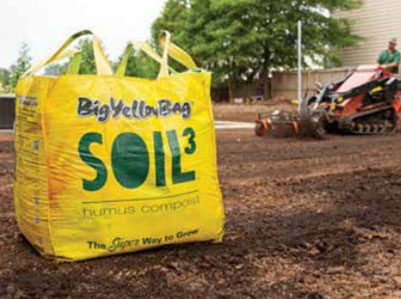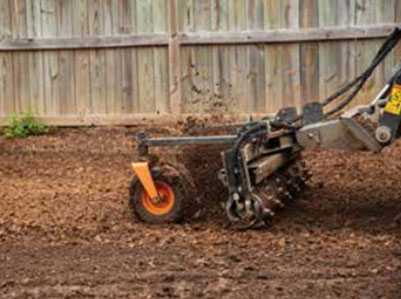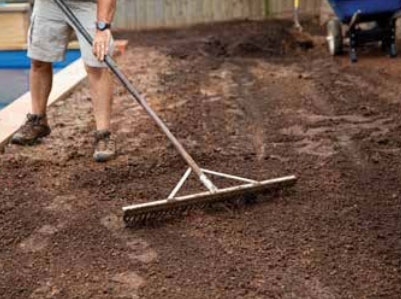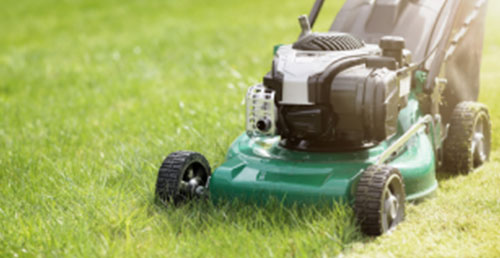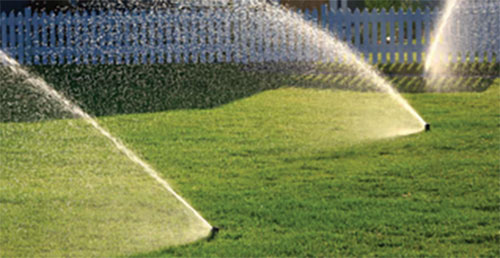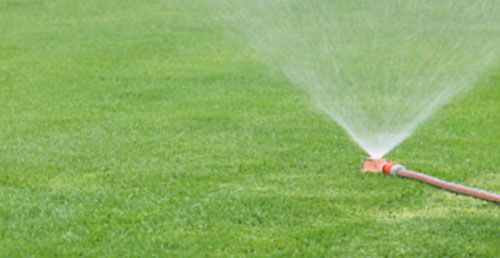Care & Installation
POST-INSTALLATION CARE
It is essential to begin watering new turfgrass sod immediately upon establishment. This can be done by hand-watering with a water hose and nozzle, hose-end sprinkler, in-ground irrigation system, or any combination thereof. When watering new sod, make sure that the sod and the soil layer immediately beneath the sod is moist to a depth of ½ to 1 inch (0.125 to 2.5 cm). Lifting the corners of random pieces of sod and checking for moisture is a good way to ensure that the sod is wet. Corners, edges, and areas exposed to full sun are particularly prone to drying out. Turfgrass leaves that are wilted and/or bluish-gray in color often appear in these areas first and are a sign of drought stress.
As the sod begins to root, irrigation or hand-watering can be scheduled less frequently. Newly laid sod should be mowed once the underlying surface is firm enough to support it, but should not be prolonged to the point where significant scalping can occur.
As the sod begins to root, irrigation or hand-watering can be scheduled less frequently. Newly laid sod should be mowed once the underlying surface is firm enough to support it, but should not be prolonged to the point where significant scalping can occur.
TIPS FOR SUCCESSFUL INSTALLATION
- Soil tests are the most accurate and reliable way to determine soil nutrient status and pH when tilling in nutrients or other amendments prior to sodding.
- Soil tests often take several days or weeks to be processed so conduct any necessary sampling and testing far enough ahead of time to receive the results from the lab prior to tillage or other soil preparation.
- Tilling in soil amendments is the most effective way to ensure that sod has adequate rooting depth to maximize drought tolerance and survival during prolonged drought.
- Lay sod in a staggered, brick-like fashion perpendicular to slopes.
- In hot weather, protect unlaid pallets of sod by placing them in the shade until planting.
- Water multiple times per day to keep the newly laid sod moist until it is firmly rooted, which usually occurs in 1-2 two weeks.
- Avoid heavy use of the sod until it has firmly rooted and has been mowed 2-3 times.
- Preventative fungicides are extremely valuable when laying Tall fescue, Kentucky bluegrass, or other cool-season species of turfgrass during periods of hot weather.
- Last but not least when laying new sod, be sure to remember Green Side Up!

SITE ASSESSMENT
The first step in establishing new sod is to assess the existing site and design a plan for proper planting. Some sites may have existing vegetation, debris, or other items in place that need removal. It is also important to inspect the perimeter of the site to see if there are obstructions in place that may prevent adequate sunlight, water, or even maintenance equipment from reaching the lawn. If potential obstructions or debris exist, it is best to remove them prior to preparing the soil for sodding. This is also a good time to take initial measurements of the lawn so that you can estimate the budget, purchase the correct amount of sod, determine what type of tillage or other equipment can access the site, and design irrigation plans if needed.
SOIL PREPARATION
Proper soil preparation is an essential step in ensuring long-term success of newly established lawns. Soils that are high in clay are easily compacted and can benefit dramatically from soil amendments containing organic matter, potting soil, or other amended topsoils commonly found in lawn and garden centers. Similarly, very sandy soils can also benefit from these products as a result of increased water holding capacity. In either of these cases, incorporating soil amendments is the most important and effective way to ensure your newly laid sod can establish roots after planting. Place bags or loads of soil amendments evenly throughout the lawn and incorporate them into the existing soil as evenly as possible.
Perennial turfgrasses are some of the most hardy species of plants for use in urban sites, as is demonstrated by their success when planted on hard, compacted soils. While tilling may not be necessary, or even possible in all cases, tilling the soil prior to sodding is the most important and effective way to ensure your newly laid sod can establish roots after planting. Furthermore, university research shows that tilling to a depth of 4-6 inches (10-15 cm) will dramatically improve drought tolerance and turfgrass survival during prolonged periods of no rainfall or irrigation.
When tilling, make sure the final grade is sloped away from any homes or buildings and/or towards any drain lines or outlets such that water drains away from the home. Be sure to fill in any low spots and remove any high spots. After tilling is complete, firm up the surface enough that it can be walked on without leaving significant depressions from foot traffic.
SOD INSTALLATION
New sod should be established by laying it in rows that are perpendicular in direction to the most severe slope. Be sure to begin laying the sod at the point farthest away from the entrance so that you are not walking over new sod after it is laid. Also, if possible, it is often helpful to select a hardscape with a straight line as a starting point. This makes it easier to continue straight lines as sod is laid throughout the new lawn and prevents excess waste or moving of sod after it is laid.
If possible, make one final pass with a rake as the sod is being laid to ensure good sod-to-soil contact. Lay each row of sod in a staggered, brick-like fashion and ensure that each slab or roll of sod is laid firmly in place to the adjacent pieces and that the edges do not overlap. Edges that overlap will dry out easily and will likely be scalped during the first mowing. If possible, rolling the newly laid sod with a drum-type, water-filled roller immediately after planting is a great way to make sure the sod is firmly in place with good sod-to-soil contact.

WHEN TO WATER
Freshly cut sod contains enough moisture in the leaves, roots, and soil to keep the grass healthy and alive for transport and planting. However, once the sod is laid at the site it will continue to transpire water that will need to be replaced by either rainfall or supplemental irrigation.
WATERING TIP #1
It is essential to begin watering new turfgrass sod immediately upon establishment. This can be done by hand-watering with a water hose and nozzle, hose-end sprinkler, in-ground irrigation system, or any combination thereof. When watering new sod, make sure that the sod and the soil layer immediately beneath the sod is moist to a depth of ½ – 1 inch
WATERING TIP #2
Lifting the corners of random pieces of sod and checking for moisture is a good way to ensure that the sod is wet. A screwdriver, pocket-knife, or other sharp implement is a useful tool to inspect the soil beneath the sod. If the implement easily goes into the soil, then it is likely sufficiently wet.
WATERING TIP #3
Make certain the entire lawn is receiving water. Corners, edges, and areas exposed to full sun are particularly prone to drying out. Also pay particular attention to sod laid adjacent to hardscapes as these areas can dry out sooner than others. Turfgrass leaves that are wilted and/or bluish-gray in color often appear in these areas first and are a sign of drought stress.
WATERING TIP #4
During the first few days of establishment, it is important to water newly laid sod frequently enough that the sod and top ½ – 1 inch of soil immediately beneath the sod remain wet. This may require frequent, light applications of water applied multiple times per day. This is particularly true on hot, arid, and/or windy days during the grow-in period.
WATERING TIP #5
Prevent over-watering by paying attention to runoff on sloped areas or standing water on flat areas. This is important for water conservation but also for plant health. Turfgrass roots need oxygen for respiration, and over-irrigation can slow or prevent new roots from emerging and establishing in the soil.
WATERING TIP #5
Prevent over-watering by paying attention to runoff on sloped areas or standing water on flat areas. This is important for water conservation but also for plant health. Turfgrass roots need oxygen for respiration, and over-irrigation can slow or prevent new roots from emerging and establishing in the soil.
HOW TO WATER
Proper watering techniques are an essential part of caring for newly established sod. There are many different ways to water sod, each with different strengths. When used properly, in-ground systems, portable hose-end sprinklers, and hose-end nozzles can all be effective tools for watering newly laid sod.
IN-GROUND IRRIGATION SYSTEMS
In-ground irrigation systems often require professional installation but are a great way to effectively irrigate large areas. In-ground irrigation systems can also be programmed to run at specific days and times, allowing for customizable watering schedules during turfgrass establishment. Things to consider when scheduling watering programs for newly laid sod include:
- Morning and evening are good times to saturate the sod and allow it to soak into the top 1/2 – 1 inch of soil due to reduced lossed from evaporation.
- Mid-day to early afternoon is the most likely time for newly laid sod to dry out so be sure to schedule at least one mid-day irrigation event during the first few days or weeks of establishment.
- As roots begin to penetrate the soil and sod is difficult to lift up, then this is an indication that irrigation length and frequency can be reduced.
- Pay close attention to corners and edges to make sure that irrigation coverage is sufficient to water newly laid sod and adjust heads to eliminate overspray onto non-turfgrass areas such as driveways, streets and sidewalks.
HOSE-END SPRINKLERS
Hose-End Sprinklers range in price, durability, and complexity but their portability makes them a great way to water newly laid sod. They can be easily moved from place to place in the lawn as the sod requires can be scheduled on inexpensive electronics timers, and can even be used by hand to irrigate small or irregularly shaped areas that would otherwise be hard to reach. Things to consider when using Hose-End Sprinklers to water newly laid sod include:
- Output and coverage vary widely by nozzle-type so be sure to select one that will deliver a sufficient volume and pattern of water.
- Hose-End Sprinklers with larger droplet sizes will reduce evaporative losses and are an important consideration, particularly for mid-day watering when evapotranspiration rates may be high.
- Hose-End Sprinklers often need to be moved manually multiple times per day to adequately reach all of the newly laid sod, particularly in larger areas.
- All of the same guidelines from in-ground irrigation systems also apply to hose-end sprinklers with regard to timing, frequency, and adjustment.
POST-INSTALLATION CARE OF NEW SOD
Newly laid sod should begin to produce new roots within the first few days, which can be observed by gently pulling the corners and edges of the new sod. Prior to placing mowers or other equipment onto the newly laid sod, it is important that the irrigation has been reduced such that the sod and underlying surface is firm enough to support food traffic, mowing, etc. without producing footprints, tire tracks, or other depressions.
MOWING
Mowing newly laid sod is an important component of encouraging lateral growth through tillers, rhizomes, or stolons. Newly laid sod should be mowed once the underlying surface is firm enough to support it and should not be prolonged to the point where significant scalping can occur. All turfgrasses, including newly laid sod, should be mowed using sharp mower blades within the recommended ranges of mowing heights frequently enough to prevent from removing more than 1/3rd of the leaf blade at any one time. Recommended mowing heights vary by turfgrass species and can be found on The Lawn Institute’s website.
FERTILIZATION
Newly laid sod can be fertilized immediately prior to establishment, during establishment, or as needed after establishment. Selecting the appropriate fertilizer and application rate should be based on soil test results. More information on turfgrass fertilization can be found on The Lawn Institute’s website or in the Turfgrass Fertilization pamphlet provided by Turfgrass Producers International.
IRRIGATION
As newly laid sod begins to root into the soil, irrigation applications should gradually be reduced from multiple times per day during establishment to only once every few days. Deep and infrequent watering of established turfgrass provides a balance of oxygen and water in the soil that encourages deep, healthy roots.




